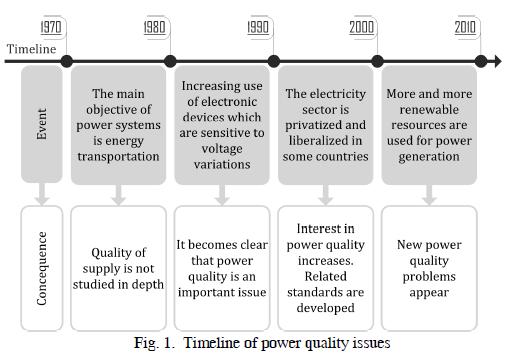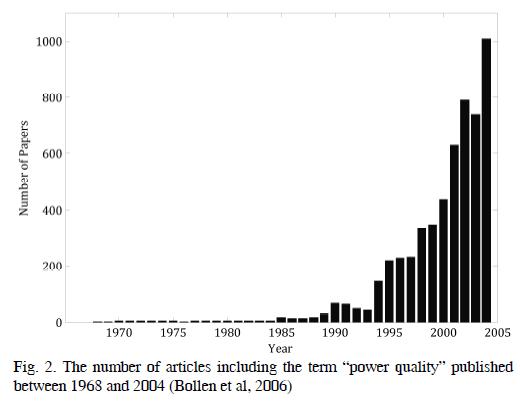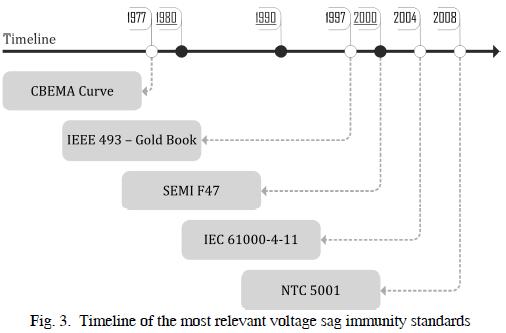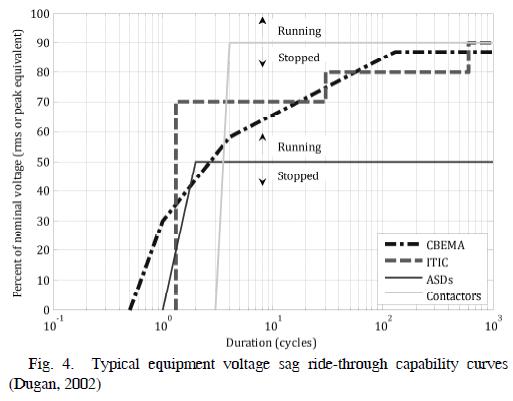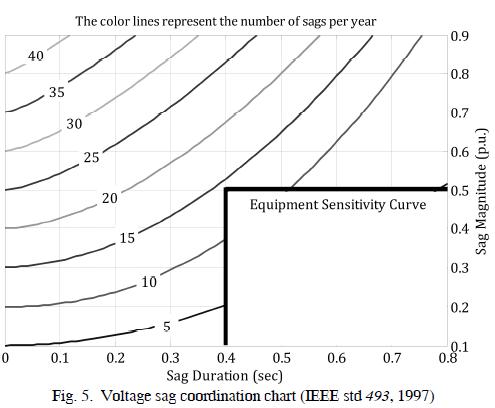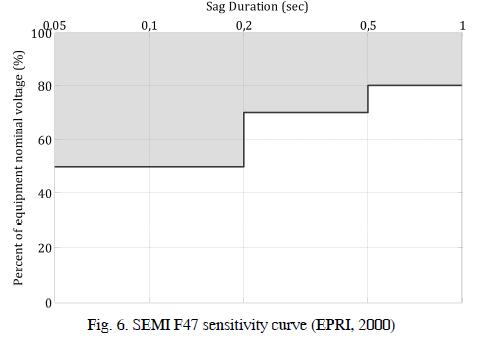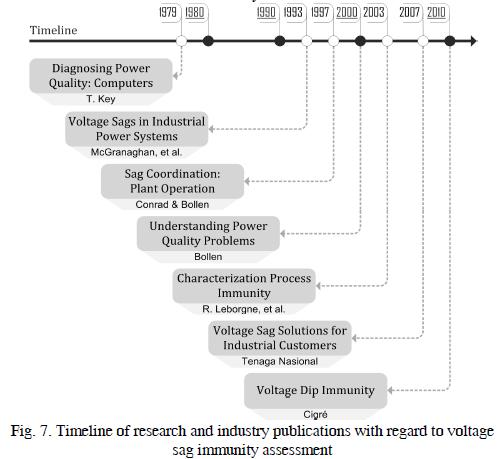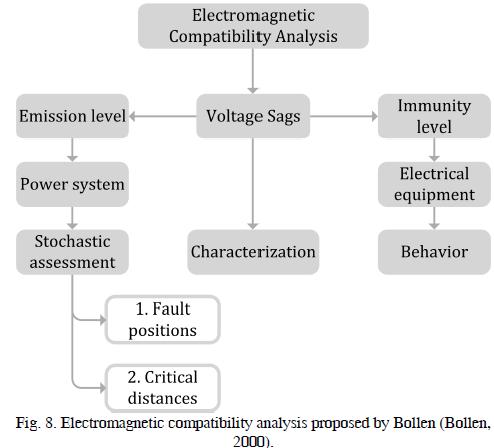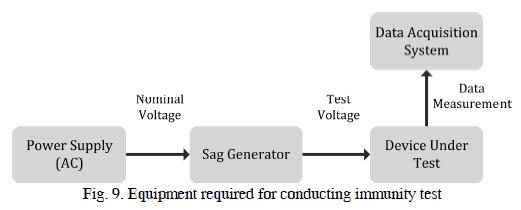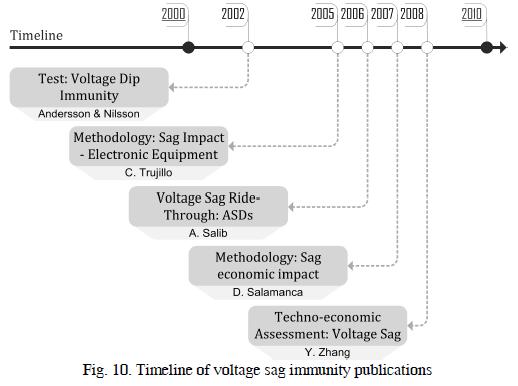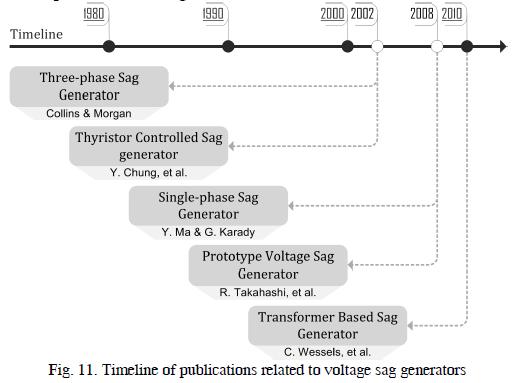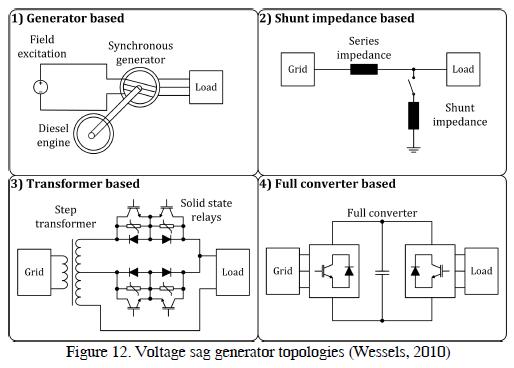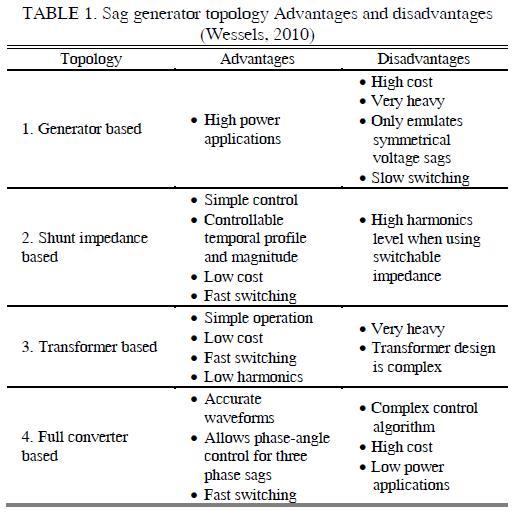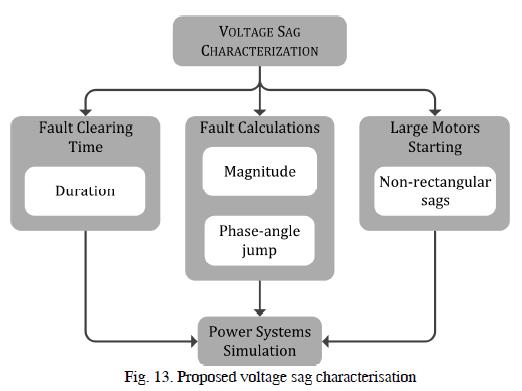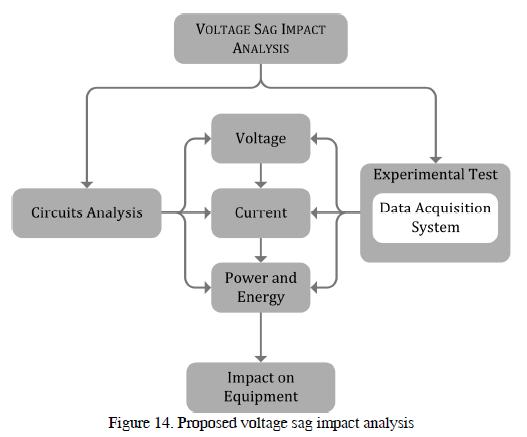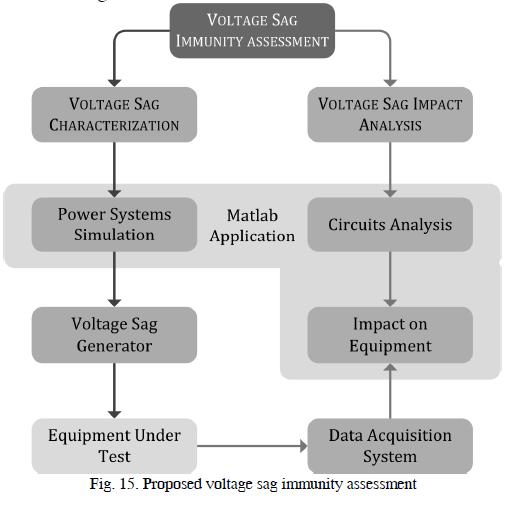Serviços Personalizados
Journal
Artigo
Indicadores
-
 Citado por SciELO
Citado por SciELO -
 Acessos
Acessos
Links relacionados
-
 Citado por Google
Citado por Google -
 Similares em
SciELO
Similares em
SciELO -
 Similares em Google
Similares em Google
Compartilhar
Ingeniería e Investigación
versão impressa ISSN 0120-5609
Ing. Investig. v.31 supl.2 Bogotá out. 2011
The state of the art and new developments in voltage sag immunity
Estado del arte y nuevos desarrollos en inmunidad frente a huecos de tensión (sags)
Joaquín Caicedo1, Felipe Navarro2, Edwin Rivas3 and Francisco Santamaría4
1 Was born in Bogotá, Colombia in 1988. Currently, he is pursuing the Bachelor degree in electrical engineering at the Universidad Distrital Francisco José de Caldas, Bogotá, Colombia. His main areas of interest are electromagnetic compatibility and electric power quality. (e-mail: jecaicedon@correo.udistrital.edu.co).
2 Was born in 1987, in Sucre, Colombia. Currently, he is pursuing the Bachelor degree in electrical engineering at the Universidad Distrital Francisco José de Caldas, Bogotá, Colombia. His areas of interest are electromagnetic compatibility and electric power quality.
3 Received the Master degree in electrical engineering from the Universidad de Valle, Cali, Colombia, in 1994, and the Master and Ph.D. degrees from the Universidad Carlos III de Madrid, Madrid, Spain, in 2007, and 2009. His areas of interest are power systems and signal processing for power transformer condition monitoring.
4 Recibió el título de Master en ingeniería eléctrica de la Universidad Nacional de Colombia, Bogotá, Colombia, en 2002. Actualmente es candidato a Ph.D. en la Universidad Nacional de Colombia, Bogotá, Colombia. Sus áreas de interés son alta tensión, compatibilidad electromagnética y calidad de la energía eléctrica.
ABSTRACT
This paper presents the state of the art regarding electrical equipment's immunity to voltage sags. It deals with immunity analysis and voltage sag generators. An alternative methodology for testing equipment regarding voltage sag is proposed, along with immunity assessment. A comprehensive bibliographic review was made, describing voltage sag immunity standards and selected research and industry publications. The proposed methodology for assessing immunity was based on the literature presented and the authors' work.Index Terms: electromagnetic compatibility, equipment immunity, power quality, sag generator, voltage sags
RESUMEN
En este artículo se presenta el estado del arte en inmunidad de equipos eléctricos frente a huecos de tensión. Se incluyen dos grandes tópicos: análisis de inmunidad y generadores de huecos de tensión. Como resultado, se propone una metodología alternativa para analizar la inmunidad de equipos eléctricos a los huecos de tensión. También se presenta una completa revisión bibliográfica, incluyendo estándares con referencia a inmunidad y una selección de publicaciones de la academia y la industria. La metodología propuesta para el análisis de inmunidad se basa en la bibliografía presentada y el trabajo de los autores.Palabras claves: Calidad de potencia, compatibilidad electromagnética, generador de huecos de tensión, huecos de tensión, inmunidad de equipos eléctricos.
1. Introduction
Voltage sags (or dips) are among the most common disturbances associated with power quality. They are short duration reductions in RMS voltage caused by faults in electric power systems, load variations and the starting up of large motors. This phenomenon affects several types the proper operation of end-users' electrical equipment (Bollen, 2000).
A piece of equipment or a system's ability to function satisfactorily in its electromagnetic environment is known as electromagnetic compatibility. This concept is studied from two perspectives: immunity and emission levels (Bollen et al, 2006). As an electromagnetic interference phenomenon, voltage sags are studied from these points of view.
Voltage sags are characterised by their stochastic behaviour as power systems' faults are difficult to predict; reducing voltage sag emission level is thus not the best solution. Immunity must be increased to reach electromagnetic compatibility between an electric power system and an end-user's equipment (Bollen, 2000).
Immunity analysis is a methodology for determining different types of electrical equipment's susceptibility to voltage sags. This allows solutions to be established for increasing their immunity and, consequently, obtaining electromagnetic compatibility to ensure proper operation.
A voltage sag generator is needed for immunity analysis in studying the phenomenon in a safe environment, without causing real power system faults.
2. The state the art regarding voltage SAGS
Before 1980, power systems were only meant to transport electricity from generators to end-users, meaning that supply quality was not studied in depth (Bollen, 2000).
Power quality became important during the following decades for three reasons: the mass use of electronic devices becoming more and more sensitive to voltage variations, the privatisation and liberalisation of energy markets around the world and the use of renewable resources for power generation (Bollen et al, 2006). Figure 1 summarises the evolution of the power quality problem during the last four decades, taking (Bollen, 2000) and (Bollen et al, 2006) as reference.
In order to demonstrate the growing interest in electric power quality, Figure 2 shows the number of publications having the term ''power quality'' in either their abstract or index terms, published between 1968 and 2004, according to the Inspec database cited by Bollen and Gu (Bollen et al, 2006) containing about 12 million bibliographic abstracts from scientific publications in the field of engineering.
Interest in voltage sags has increased significantly; likewise, an important contribution for the study of this phenomenon has been carried out by the International Electrotechnical Commission (IEC) by introducing standards concerning electromagnetic compatibility.
A literature review of the three types of publications is presented (standards, research and industry publications) for a comprehensive analysis of the evolution of voltage sag relevance.
A. Voltage sag standards
Figure 3 gives a selection of standards specifically dealing with electrical equipment immunity and voltage sag analysis. Although there are many related technical standards, only the most relevant in industry and research have been cited.
The Computer Business Equipment Manufacturers' Association (CBEMA) developed the first sensitivity curve (1977) and it represents the typical performance of computers in certain voltage magnitude and duration conditions. The Information Technology Industry Council (ITIC) developed this curve.
Figure 4 shows CBEMA and ITIC curves and typical variable speed drives (ASD) and motor contactor sensitivity curves (Dugan, 2002).
IEEE 493 (golden book) (IEEE std 493, 1997) is a technical standard presenting the fundamentals of reliability and its application to designing commercial and industrial power systems. Chapter 9 of this standard refers to voltage sag analysis, including theoretical methods for calculating magnitude, duration and frequency. The standard's main contribution lies in its approach to voltage sag coordination charts to estimate how many times a piece of equipment cannot operate properly in a given electromagnetic environment.
Figure 5 presents a sample chart for voltage sag coordination. The coloured lines represent the number of voltage sags with some duration and magnitude occurring each year in a given distribution system. The chart also includes a particular device's sensitivity curve. By overlaying the curves, it states that the piece of equipment fails about 15 times a year on average (IEEE std 493, 1997).
Specification for Semiconductor Processing Equipment Voltage Sag Immunity (SEMI) standard F47 specifies a new sensitivity curve for semiconductor-based devices. Developed in 2000 by the semiconductor industry, it is a revision of SEMI F42. Figure 6 shows the SEMI F47 sensitivity curve. The equipment must be able to continuously operate without interruption during conditions identified in the area above the defined solid line (EPRI, 2000).
Standard IEC 61000-4-11 ''Testing and measurement techniques - Voltage dips, short Interruptions and Voltage Variations Immunity Tests'' proposes a method for determining electrical equipment tolerance to voltage sags. It identifies a desired number of voltage sag magnitudes and durations that equipment being tested must tolerate, this being equivalent to a sensitivity curve (Bollen, 2000).
Colombian standard NTC 5001 recommends the limits and evaluation methodology at the point of common coupling. This standard deals with specific voltage sag issues. For instance, it describes the procedure for developing voltage sag coordination charts enabling statistical analysis of recorded events (ICONTEC, 2010).
Standards focus on defining conditions for performance tests on end-user's electrical equipment during voltage sags. The methodology for assessing equipment immunity and the voltage sag generator are considered.
B. Immunity analysis
The objective of immunity analysis is to determine how much voltage sag magnitude and duration equipment can stand without failure or interruption (CIGRE/CIRED/UIE, 2010).
Figure 7 shows a timeline for some scientific publications regarding immunity analysis. The high density of work done in the past two decades demonstrates the growing interest in the subject.
The first step for further immunity analysis was the recognition of the problem. Thomas Key, in his article "Diagnosing power quality-related computer problems" (1979) (Key, 1979), emphasised electronic equipment susceptibility to voltage fluctuations and its economic impact on modern industries.
McGranaghan et al., (McGanaghan, 1993) performed a more detailed analysis of voltage sags causes in 1993 and this phenomenon's impact on fundamental electrical and electronic equipment in industry, such as adjustable speed drives (ASDs), programmable logic controllers (PLCs) and motor contactors, thereby allowing solutions through implementing power conditioners to keep voltage within acceptable limits.
Based on the contributions made by the IEEE 493 in 1997, Conrad and Bollen (Conrad et al, 1997) proposed techniques for coordinating sensitive equipment and its electromagnetic environment, taking into account voltage sag characteristics' measurement and predictions. This main contribution of this paper concerns theoretical and empirical approaches to consider emission and immunity level.
Bollen presented a comprehensive guide for electromagnetic compatibility analysis of voltage sags in 2000 (Bollen, 2000), based on three main areas: characterisation, equipment behaviour and stochastic assessment (Figure 8).
Bollen's work consolidated a methodology for analysing electromagnetic compatibility; researchers and industry efforts since then have focused on developing new methodologies for analysing emission levels and immunity levels to study specific scenarios (e.g. the effect of voltage sags on power electronic equipment). New research thus includes the study of several pieces of electrical and electronic equipment to analyse different production processes' immunity level.
Electrical equipment immunity
Several parameters affect electrical equipment performance during voltage sags in power supply (CIGRE/CIRED/UIE, 2010):
- Sag magnitude
- Sag duration
- Phase-angle jump
- Current magnitude at the end of the voltage sag
- Source impedance
- Devices connected to the same network point
The main parameters defining an immunity study are magnitude and duration, the expected result in this type of assessment being a sensitivity curve.
In its technical guide, "Voltage Sag Solution for Industrial Customers" (2007) (Tenega Nasion Berhald, 2007), Tenaga Nasional Berhad the largest electric utility in Malaysia presented a detailed description of immunity tests on electrical equipment. The general scheme is shown in Figure 9.
Industrial processes immunity
An industrial process' immunity depends on the immunity of particular electrical equipment. However, a distinction is made between equipment and process to achieve a more accurate financial analysis because financial losses occur if all or part of the process fails. The complex interaction between electrical power equipment, monitoring equipment and measuring equipment makes immunity assessment of each process particularly difficult (CIGRE/CIRED/UIE, 2010).
The CIGRE / CIRED / UIE C4.110 working group (2010) (CIGRE/CIRED/UIE, 2010) introduced the process immunity time (PIT) concept. PIT's ultimate goal is to determine critical equipment in the production process by measuring the period of time each piece of equipment is able to withstand demand without affecting the process regarding voltage sag conditions.
Immunity study of both equipment and processes is a topic of great interest for academics. The main publications during the last decade are shown in chronological order in Figure 10 and briefly described below.
Andersson and Nilsson (2002) (Andersson et al, 2002) presented a complete study of industrial process immunity based on three factors: cost, failure frequency and process interaction.
Trujillo examined the impact of voltage sags on power electronic equipment in 2005 (rectifiers and converters) (Trujillo, 2005). The proposed methodology was based on four key areas: identifying sensitive equipment, sensitivity curve determination, power system characterisation and electromagnetic compatibility analysis.
Salib (2006) (Salib, 2006) described the development of a boost converter to mitigate voltage harmonics and reduce the impact of voltage sags on ASDs.
Salamanca presented a methodology in 2007 for studying the economic impact of voltage sags on industrial customers using a Bayesian network-based expert system (Salamanca, 2007).
Zhang (2008) (Zhang, 2008) presented a comprehensive techno-economic assessment of voltage sags. This work focused on five aspects: voltage sag estimation, flexible AC transmission systems (FACTS) modelling for failure analysis, investment analysis, FACTS optimal location to mitigate voltage sags and reviewing the quality of power available on the market.
Voltage sag generators
Voltage sag generators are fundamental for immunity analysis of electrical equipment. Figure 11 gives some related work published during the last decade.
Collins and Morgan described the implementation of a three-phase sag generator in 2002 for testing industrial equipment from a synchronous generator, controlling magnitude and duration (Collins, 2002).
Chung et al., proposed a sag and swell generator through a shunt reactor in 2002 which also allowed controlling magnitude and duration, varying control thyristor firing angle (Chung et al, 2002).
Yan and Karady described the construction of a voltage sag generator in 2008 based on an autotransformer and two solid state relays which allowed switching between two voltage levels (before and during the sag) (Yan, 2008).
Takahashi et al., (2008) (Takahashi et al, 2008) proposed a three-phase sag generator based on inverters, with digital control of symmetrical components.
Wessels, Fuchs and Lohde (2010) (Wessels, 2010) presented four different voltage sag generator topologies. Figure 12 gives the basic outlines for these topologies and Table 1 summarises each one's advantages and disadvantages.
3. New developments in voltage SAG immunity
A. Proposed methodology for immunity assessment
The design and construction of a 1 kVA shunt impedance voltage sag generator was thus proposed to validate the methodology described here for testing electrical equipment and assessing voltage sag immunity.
The methodology also included developing a computational application in Matlab to facilitate voltage sag characterisation and analysis for assessing voltage sag immunity.
Figure 13 shows that characterisation was based on power system simulated events defining the parameters being considered:
- Sag duration depended on fault-clearing time provided by electrical protection in a power system. Sag duration was determined by simulating electrical protection behaviour dealing with system faults;
- Magnitude and phase-angle jump depended on fault location and line impedance. Sag magnitude and phase-angle jump were determined in different nodes of a power system by simulating system faults; and
- Voltage profile shape was another characteristic taken into consideration. Non-rectangular sags were studied by modelling and simulating the start of large motors in power systems.
Characterisation was based on power system simulation using the tool developed in Matlab, also allowing generating the simulated voltage sag through the generator for studying the impact of different power system topologies.
The behaviour of voltage and current under load conditions was studied to determine the load's power and energy, thereby establishing solutions for voltage sag ride-through. This phase was carried out by simulation in the software so developed and experimental tests on electrical equipment using the voltage sag generator. The proposed voltage sag impact analysis is shown in Figure 14.
The entire voltage sag immunity assessment methodology is shown in Figure 15.
4. Conclusion
The growing interest in power quality is remarkable, as well as the study of particular phenomena such as voltage sags. However, given that immunity analysis is unique for each process and piece of electrical equipment, many issues still need to be studied.
Voltage sag immunity assessment based on experimental tests with sag generators is an accurate way of establishing fast and cheap solutions. Furthermore, considering power system topologies for generating voltage sags allows studying a piece of equipment's behaviour in specific electromagnetic environments.
Theoretical calculations, simulations and experimental tests provide an assessment having a strong-enough background to deal with the voltage sag problem in modern industry, and also provide novel elements for research.
Further research in this area should address the characterisation of several processes and pieces of electrical equipment to provide a broad enough bibliographical reference to facilitate assessing immunity based on empirical knowledge.
5. References
Andersson, T. and Nilsson, D. ''Test and evaluation of voltage dip immunity''. STRI AB, Vatenfall AB, Chalmers University of Technology. Gotemburg. 2002. M. S. thesis. [ Links ]
Bollen M. and Gu, I. Signal Processing of Power Quality Disturbances. IEEE Press on Power Engineering, 2006. [ Links ]
Bollen, M; Understanding Power Quality Problems: Voltage Sags and Interruptions. IEEE Press on Power Engineering, 2000. [ Links ]
Chung, Y. et al. ''Voltage sag and swell generator with thyristor controlled reactor''. Proceedings. PowerCon 2002. International Conference on Power System Technology. R&D Center, LG Ind. Syst. Co. Ltd, Kyunggi-Do, South Korea, 2002. [ Links ]
CIGRE/CIRED/UIE Joint Working Group C4.110. Voltage Dip Immunity of Equipment and Installations. 2010. [ Links ]
Collins, E. and Morgan, R. ''A three-phase sag generator for testing industrial equipment''. IEEE Transactions on Power Delivery. Dept. of Electr. & Comput. Eng., Clemson Univ., SC, 2002. [ Links ]
Conrad, L. and Bollen, M. ''Voltage sag coordination for reliable plant operation''. IEEE Transactions on Industry Applications. Plainfield, IN : Cinergy Corp, 1997. [ Links ]
Dugan, R. et al. Electrical Power Systems Quality. (2 Ed.). New York: McGraw-Hill, 2002. [ Links ]
EPRI. Cost-Effective Storage Technologies as Embedded Solutions for Ride-Through. Voltage Sag Testing of Advanced Machine Tools at NIST. Technical report. 2000. [ Links ]
ICONTEC. NTC 5001. Calidad de la Potencia Eléctrica. Límites y Metodología de Evaluación en Punto de Conexión Común. 2008. [ Links ]
IEEE Std 493. IEEE Industry Applications Society. IEEE Recommended Practice for the Design of Reliable Industrial and Commercial Power Systems. 1997. [ Links ]
Key, T. ''Diagnosing Power Quality-Related Computer Problems. IEEE Transactions on Industry Applications''. Albequerque, NM: Sandia Laboratories, 1979. [ Links ]
McGranaghan, M. ''Voltage sags in industrial systems''. IEEE Transactions on Industry Applications. Knoxville, TN: Electrotek Concepts Inc, 1993. [ Links ]
Salamanca, D. ''Metodología para evaluar el impacto económico de los sags de voltaje en usuarios industriales conectados a un sistema de distribución radial''. Ingeniería Eléctrica y Electrónica, Universidad de los Andes. Bogotá, 2007. Thesis. [ Links ]
Salib, A. ''Voltage Sag Ride-Through and Harmonics Mitigation for Adjustable Speed Drives Using Dual-Functional Hardware. Electrical and Computer Engineering'', University of Waterloo. Waterloo, 2006. M. S. thesis. [ Links ]
Takahashi, R. et al. ''A prototype implementation of a voltage sag generator''. Induscon. VIII International Conference of Industrial Appilcations. Federal University of Itajubá - Power Electronics and Applications Research Group (GPEPA). Brazil, 2008. [ Links ]
Tenaga Nasional Berhad. Voltage Sag Solutions for Industrial Customers. Power Quality Guidebook. 2007. [ Links ]
Trujillo, C. ''Metodología para la evaluación del impacto de las variaciones de tensión (sags) sobre equipo electrónico de potencia''. Ingeniería Eléctrica, Universidad Nacional de Colombia. Bogotá, 2005. M. S. thesis. [ Links ]
Wessels, C; Fuchs, F.W. and Lohde, R. ''Transformer Based Voltage Sag Generator to perform LVRT and HVRT Tests in the Laboratory''. 14th International Power Electronics and Motion Control Conference, EPE-PEMC. Kiel, Germany. Institute of Power Electronics and Electrical Drives, Christian-Albrechts-University of Kiel, 2010. [ Links ]
Yan, M. and Karady, G. ''A single-phase voltage sag generator for testing electrical equipments''. Transmission and Distribution Conference and Exposition. Dept. of Electr. Eng., Arizona State Univ., Tempe, AZ, 2008. [ Links ]
Zhang, Y. ''Techno-economic Assessment of Voltage Sag Performance and Mitigation''. Manchester University. Manchester, 2008. Dr. thesis. [ Links ]













